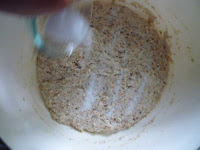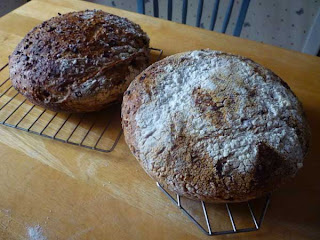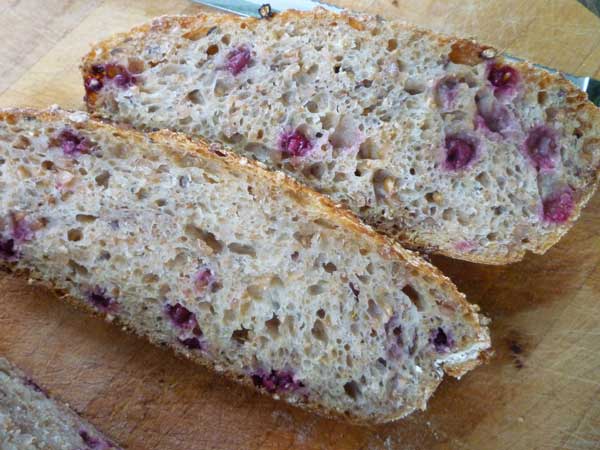Multigrain Bread with Pomegranate Seeds and grapejuiced-soaked Whole Wheat berries
My wife's friend Janet gave me some
Robin Hood Multigrain Bread flour. She and her husband tried some bread made with this flour, and decided they didn't like it. Since she knows I like to bake, I had this large bag of flour given to me.
 |
Picture from the Robin Hood Web Site:
Will they make me take it down? |
This is a flour I've used before. I once bought a small bag of it, long long ago, and ended up taking it camping with me, because I was in the woods with lots of other people who I thought would help me eat bread made over a campfire, even if the bread turned out to be made from processed flour. We used up the flour, and while the bread tasted okay, it is not a flour that I figured I'd ever buy for myself again, as I prefer whole grains.
My biggest problem with this bread is in its 'enriched flour'.
This multigrain flour contains mostly all purpose or bread flour (with the additives that they call enrichment, and some other things to aid its shelf life), along with an unknown quantity of whole wheat flour, some rye flour, some cracked wheat, cracked rye, and some whole flax seeds. I prefer to add the grains I want, in the quantities I want, and not have some corporation sell me a pile of stuff I don't want.
(See the section 'Notes to Myself' below to learn what I found when I examined the ingredients of this flour.)
This experimental Tartine-like loaf:
To this bread, I have added some whole wheat kernels that I've cooked in a pressure cooker, and soaked overnight in grape juice, along with the seeds from one pomegranate.
The quantities and method are from the Tartine Bread book. I simply added the extra ingredients during the first fold in the bulk fermentation stage.
 |
| Leaven made overnight with the Robin Hood Multigrain Bread Flour |
 |
| Mis en place |
 |
| Float test |
 |
| Initial mixing by hand |
 |
| Added 1 TBSP of sourdough to the overnight soaking of these grapejuice soaked wheat berries |
 |
| These are hard wheat berries, but they softened up nicely, retaining some 'chewiness' |
 |
| salt added |
 |
| Pomegranate Seeds and Grapejuice-soaked wheat berries added to the sourdough mix at first turn |
 |
| The seeds are turned into the dough |
 |
| Several hours of turns later, some seeds are still on the surface |
 |
| Proofing |
 |
| baked |
 |
| sliced |
 |
| crumb |
Results
The Pomegranate Seeds give the bread a very interesting scent, colour and texture, and the wheat berries soaked in grape seeds complement the taste of them quite nicely.
If it weren't for the flour, this bread would have been tremendous. I think that I'll try adding these two ingredients to a whole wheat and whole rye bread someday.
Notes to Myself
- Throw away this bag of Robin Hood Multigrain Bread Flour. It appears to be dangerous. Don't even take it camping to get rid of it.
Here are the ingredients of the Robin Hood Multigrain Loaf's "enriched flour":
- Amylase (this enzyme breaks down the complex sugars into simple sugars, so bread made with this flour is going to taste a bit sweeter. Industrially, it is manufactured from Swine pancreas, or mould mushroom, neither of which sounds very nice, especially to vegetarians)
- Xylanase (this enzyme breaks down hemicellulose, a major part of plant cell walls. As a dough conditioner, it improves the dough's workability and water absorption. It is usually made by fermentation caused by microorganisms that have been genetically modified -- either fungi or bacteria.)
- Ascorbic Acid (a reduced form of Vitamin C, an antioxidant that is used to condition dough. Most of the world's Ascorbic Acid comes from China, where it is synthesized from glucose, and the microorganism Acetobacter suboxydans (a gram negative bacteria found in vinegar), acetone, and bleach.)
- Niacin * (Vitamin B3 is naturally in bran -- which is removed from white flour. Governments have mandated that it be returned to flour that has had bran removed from it, or vitamin deficiencies may occur -- causing pellagra, signs of which are diarrhea, dermatitis and dementia.)
- Reduced Iron * (This is elemental iron, and it is absorbed inefficiently by the body compared to iron sulfate or iron fumarate. Iron can be dangerous in high quantities, and it can be reactive, oxidative, and destroy vitamins. Taking Vitamin E might help with excess iron)
- Thiamine Mononitrate * (A synthetic form of Vitamin B1. It is not water soluble like other B vitamins, so it may accumulate in fat cells and ultimately cause liver disease.)
- Riboflavin * (Vitamin B2. This is made industrially by fungi and bacteria -- the bacteria has been genetically modified. The amounts of Riboflavin taken out of the whole wheat flour when the bran and germ are removed are immense, and aren't even close to being replaced by the 'enrichment'.)
- L-Cysteine Hydrochloride (This is an improving agent produced from L-cystine, which is produced commercially from animal and human hair and feathers; most vegetarians won't like this, since the animal hair comes from slaughtered animals; and humanitarians might not like it because the human hair comes mostly from women in third-world countries.)
- Azodic Carbonamide ( A synthetic chemical (C2H4O2N4 ) used to bleach flour: sometimes you see it explained as a "maturing agent" for the flour. The substance is banned as a food additive in Australia, the U.K. and Europe, but not in the U.S. and Canada. It is however, widely used worldwide in industry to make plastic and rubber. In 1966, WHO established that it was pretty much safe to use, even though it is quickly transformed into Biurea when mixed, and it stays intact when baked and ingested. Biurea (C2H6O2N4) is an amide that is supposedly biologically inert and excreted; but some animal studies suggest that it might cause kidney damage.
- Folic Acid * (The synthetic, non-biologically active form of Folate, or Vitamin B9: it can be turned into biologically useful forms in the liver, but the liver does this inefficiently and slowly. Especially because pregnant women require the vitamin to prevent Neural Tube Defects in their offspring, processed flours in many countries must be fortified with Folic Acid. The data supports the enrichment, but the levels of synthetic vitamin B9 that are now seen in our bodies and our food are not properly tested.)
---
* These enrichments are mandated by law in Canada and U.S., and likely elsewhere. The ones not marked by an asterisk will have maximum levels associated with them that the manufacturer is not allowed to go beyond.
Manufacturers are going to use the cheapest ingredients to maximize corporate profits. If they had to choose between the bottom line and our health, our health would suffer. If we have to choose between accepting this and rejecting this product, I say we should reject it.
So what do I do with this flour I had given to me? It is not good enough to feed to my organic chickens. Do I dare to put it on my compost pile, or should I just put it in a landfill?
- After baking the bread, I more carefully examined the Tartine Bread book technique. Although I've made several breads using the methodology of this book, I see now that I've been doing some things incorrectly: forgetting the bench rest stage entirely, for example. And not using any flour on my work surface, during the dividing of the dough, and the pre-shaping. This last little detail I found a bit confusing when I first read the book, so I've just left it out. But it might ultimately help my final shaping of the loaves. I'll have to practice it a bit the next time I make a Tartine-style bread.
- The web site for Robin Hood Multigrain Bread Flour speaks of shelf life: but what does it mean when they suggest that the product's age limit is 9 months, but that the shelf life is 15 months from manufacture? The web site shows how to read the manufacturing code to determine if the flour is still fresh. But the manufacturing code is hidden under the lip of the bag, so you really have to buy it and take it home before you can read it (very clever of them). The flour bag I had given to me reads:
11 076 548 13:11 3916
So it was made in 2011, on day 76 (March 17), "somewhere" in a Robin Hood plant in Canada. I was actually surprised it was that fresh.




















No comments:
Post a Comment